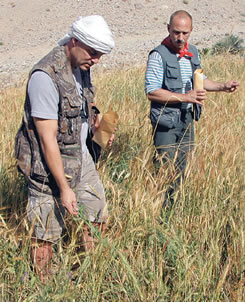Although
many growers have enthusiastically embraced lucerne, with
150,000 hectares now planted across Western Australia, it
continues to frustrate on acidic and waterlogged soils.
In a bid to
broaden Australia’s germplasm and help tackle the problem, the
Grains Research and
Development Corporation has supported seed and rhizobia
collecting missions to regions with acidic soils, such as
Turkmenistan.
Ranging
across its harsh, dry environment, researchers collected more
than 65 perennial legume accessions of 22 species.
The
majority of legumes used in Australian agriculture originate
from the Mediterranean basin, which is characterised by
neutral to alkaline, medium to fine-textured soils.
Related
article from Ground Cover, Issue 48, February 2004
Scouting for
crop ancestors in volatile outposts
By Eammon Conaghan
Deteriorating soils and a
catalogue of severe diseases can blunt the performance of
Australia’s finely bred ‘greyhound’ crop varieties. To
fortify them against such stresses, researchers are looking
to their forgotten crop ancestors, which are scattered
across the wilds of the world, including the former Soviet
states in Central Asia.
Scouting these rich sources
of hardy plant genetics through politically volatile desert
outposts requires a special breed of scientist.
Sergey Shuvalov is just
that, and during two decades with the Foreign Relations
Department of the Vavilov Institute, St Petersburg in
Russia, he has participated in numerous missions to search
for unique plant germplasm – potentially crucial to the
future robustness of Australian crops.
“Wild relatives and land
race varieties developed over centuries of farmer selection
may contain useful traits such as disease resistances or
tolerance to adverse conditions,” he says. “Harsh climatic
conditions and the saline or acid soils of places like
Tajikistan naturally select races of stress-tolerant plants
which could add resilience to newly bred varieties.”
To reach this natural
laboratory for plant selection is not easy. Tajikistan
defends a border with Afghanistan, and with garrisons and
checkpoints dispersed by a rugged mountain landscape,
‘defence’ often means resorting to minefields – not a
workplace to appeal to the average plant breeder.
Fortunately for Mr Shuvalov, the landmine warning signs are
in Russian.
Another constant source of
tension is the increasing security being applied to try to
stem the tide of drugs leaking across the border to world
black markets– and the implausibility of explaining that you
are looking for grass seeds.
In 2000 a collection
mission by scientists from the International Centre for
Agricultural Research in Dry Areas (ICARDA), and the Vavilov
Institute were confronted by unidentified gunmen several
times. On another occasion Mr Shuvalov was arrested with a
troupe of Australian researchers during a mission to eastern
Kazakhstan.
“We were told we were in a
restricted area,” he recalls. “We hadn’t seen any signs, but
apparently we were too close to the Chinese border and
therefore suspected of smuggling exotic birds. It was odd
because we were 150 kilometres from the border when arrested
and travelling in the opposite direction.
“We couldn’t convince them
who we were and eventually they brought in a ‘judge’ who
fined us $30 each, but we refused to pay and were finally
released eight hours later, after they inspected our cars.”
The latest mission to
Tajikistan, which was supported by the Australian Centre for
International Agricultural Research (ACIAR), the GRDC and
ICARDA, included three Tajikistan scientists who were able
to negotiate access to previously restricted areas.
Another distinguishing
feature of the mission was that it took a course plotted by
Nikolai Vavilov, 60 years after his death. Vavilov, after
whom the famous Vavilov Institute in St Petersburg was
named, pioneered the science of germplasm collection in the
early to mid 1900s.
“He was interested in the
history of agriculture and developed the first concepts of
where best to collect crops of greatest diversity,” Mr
Shuvalov says. “In 1920, he took charge of the Bureau of
Applied Botany (founded in 1894 and renamed the
Vavilov Institute in
1967) and developed it from a small office into the world’s
pre-eminent research institute and seed bank.”
|
 |
|
Ken Street (left) and Sergey Shuvalov collect
ancient crop varieties from Lyangar village fields. |
The Institute, which houses
320,000 accessions of different plants, is 109 years old and
has survived Tsarism, Communism and Nazi invasion. While
under fire from German forces in 1941, scientists guarding
the Institute starved to death rather than eat the packets
of rice, corn and other seeds in their desks.
“Vavilov went to Tajikistan
in 1916, although it was before he had developed his centre
of origins theory and there was little known about that
mission,” Mr Shuvalov says. “When I was in Tajikistan in
1990, we spent most of our time at an institute in Dushanbe,
but there was a feeling that Tajikistan would be a great
source of germplasm, so we began to investigate where
Vavilov went during his mission.”
Guided by a mud-map of
Vavilov’s journey almost a century earlier, the
GRDC-supported mission explored target areas of Tajikistan
for more than two weeks to collect land race seeds from
fields, harvest bundles, roadsides, orchards, threshing room
floors and cottage gardens in remote mountain villages.
Mr Shuvalov filled the role
of interpreter and logistics specialist on the mission,
which was led by an Australian, Dr Ken Street from ICARDA.
Abandoned armoured trucks
and tanks littering the roadsides were a constant reminder
of the region’s recent violent history.
“It’s hard, dangerous work,
but it’s work that has to be done,” says Dr Street, regarded
by many as the closest thing agriculture has to an Indiana
Jones. “Farmers need improved crop varieties to plant, and
breeders need the raw material to develop them.”
Dr Street’s team collected
more than 400 seed samples. They will end up in
international collections available for use free of charge
by breeders everywhere.